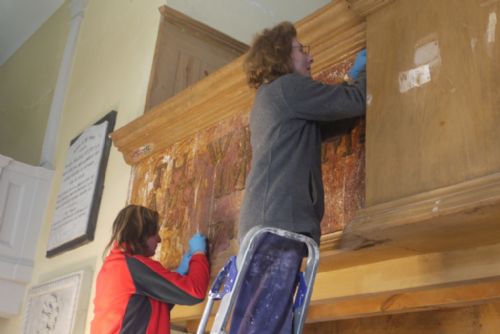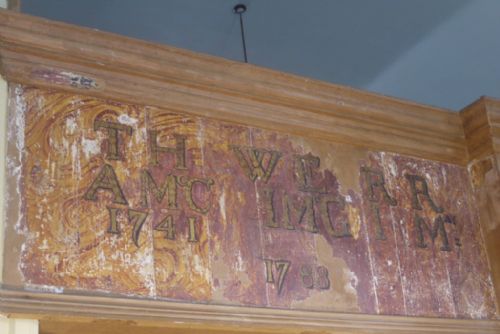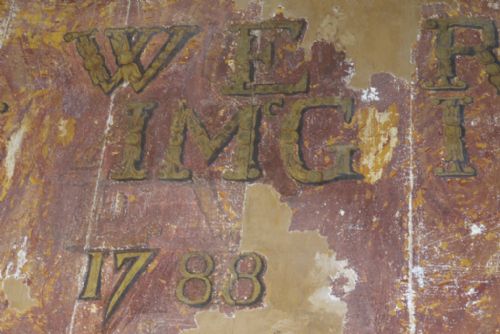The further revelations of the north loft
 Fiona and Karen of Scottish Wallpaintings Conservators have been undertaking further painstaking work on the north loft front.
Fiona and Karen of Scottish Wallpaintings Conservators have been undertaking further painstaking work on the north loft front.
During earlier conservation work in the church it was found that earlier decorative designs lay under the pine coloured varnish of the 1970's.
You can read more about the initial discovery on http://www.eastchurchcromarty.co.uk/news.asp?newsid=25
 Looking at these layers in further detail it seems that the red and yellow ochre scrolling - intended to look like wood graining - dates from 1740, when the north aisle was built. Evidence of this same scrolling has been found in each of the front table seats of the north loft and on the old loft frontage of the west loft - now hidden under the front pew as a result of a loft extension in 1758.
Looking at these layers in further detail it seems that the red and yellow ochre scrolling - intended to look like wood graining - dates from 1740, when the north aisle was built. Evidence of this same scrolling has been found in each of the front table seats of the north loft and on the old loft frontage of the west loft - now hidden under the front pew as a result of a loft extension in 1758.
You can see earlier outlines of initials faintly behind the WE and IMG - that  date from 1788, suggesting that the maroon coloured woodgraining designs were added at around this time. This graining seems to have remained until at least 1968 when photos were taken of the north loft for the Royal Commission on the Ancient and Historic Monuments of Scotland.
date from 1788, suggesting that the maroon coloured woodgraining designs were added at around this time. This graining seems to have remained until at least 1968 when photos were taken of the north loft for the Royal Commission on the Ancient and Historic Monuments of Scotland.
The longevity of this decorative finish makes it the obvious layer to take the north loft frontage back too. Sadly all  trace of the maroon has been lost from the other two sections of the north loft frontage, but they will be re-grained using the 1968 photographs as a template.
trace of the maroon has been lost from the other two sections of the north loft frontage, but they will be re-grained using the 1968 photographs as a template.
A small section of the yellow ochre and maroon graining will also be left exposed in order to show this earlier decorative style.
The photo (right ) shows Fiona's dog Bruno enjoying the warmth of some autumn sunshine.
Become a friend
Support the work of the Scottish Redundant Churches Trust in looking after historic buildings like the East Church. more »“We’re extremely fortunate to have Laing Traditional Masonry Ltd as the main contractors. They have a superb reputation, not only for the quality of their work, but also for their commitment to training apprentices – the next generation of skilled stonemasons and craftworkers ”
Victoria Collison-Owen, SRCT Director

